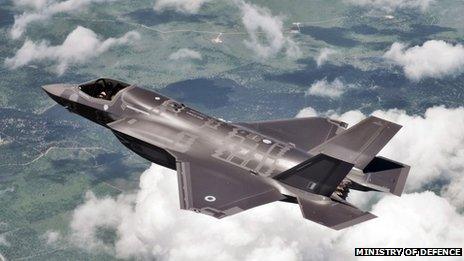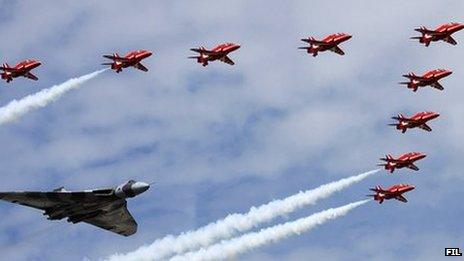Farnborough Airshow: Why it matters
- Published

The first Farnborough Airshow was in 1948
If you're looking for an aerospace executive or military high-up this week, try Farnborough, a small town in Hampshire, some 20 miles west of London.
At the nearby airfield is the biggest event in the aerospace-defence calendar, the biennial Farnborough International Airshow, external.
It is a must-do for decision-makers in the industry, no matter how much they may tell you in private that it's a chore.
"To have to be there might well be a pain in the butt, but the more important point is that not to be there can be both costly and potentially embarrassing," says analyst Howard Wheeldon, who is about to attend his 23rd Farnborough.

Farnborough Airshow 2014 in numbers
About 110,000 trade visitors
More than 100,000 public visitors
1,500 exhibitors on show
70 aircraft make up the static display
23 aircraft taking part in flying displays
$72bn worth of orders announced at the last show in 2012

It is where Boeing and Airbus, and their airline customers, announce with great fanfare multi-billion-dollar aircraft orders.
And it is where official defence delegations, preferring a rather lower profile, come to observe the latest military hardware.
Farnborough is also a place where hundreds of small sub-contractors showcase cutting-edge technology or their latest widgets.
The event has a critical mass of customers, decision-makers and the world's media, says Ben Jensen, chief technology officer at Surrey NanoSystems.
The firm, a small Surrey University spin-off, is using Farnborough to unveil a special coating used on sensors, cameras or telescopes. The material protects against distortions from light and radiation, enhancing visibility on the battlefield or in deep space.
"Our potential customers are quite specialised and spread around the world, but at Farnborough they will all be in one place at the same time," Mr Jensen says.
No-show?
At the top end of the corporate food chain is Lockheed Martin, the titan of the defence-aerospace-security industry.

Will the F-35 make an appearance? An engine fire grounded the entire fleet, putting the fighter's Farnborough showing in doubt
The US company is due to display its new all-singing, all-dancing F-35 Lightning II fighter jet, which will be used on the Royal Navy's new aircraft carriers.
But an engine fire in the US grounded the entire F-35 fleet earlier this month, so there is a question mark over when, or if, the $60m-plus jet will make an appearance.
Yet, even if the F-35 is a no-show, Lockheed will still be displaying its missile defence shields, cyber-security and communications technologies, and air traffic management systems.
With some 90 government delegations due to visit the show, it was important for Lockheed to be out in force, according to the company's UK chief executive, Stephen Ball.
"Farnborough gives us a great opportunity to showcase our business to an international audience," he told the BBC.

Look out for...
Lots of ultra-smart military types wearing dark glasses
Sopwith Camel, Wright Flyer and Bleriot XI. For those who like nostalgia
Rain. There's always rain
F-35 Lightning super-fighter. Will it fly? Huge embarrassment if it doesn't
The Textron Scorpion. A budget fighter jet yet to find a customer
Drones. They've gone mainstream

For decades, Lockheed relied on defence spending in the US and Europe. But with budgets being cut, the firm is looking for more commercial opportunities as it diversifies into new areas.
That's why Lockheed, along with several major US contractors, has taken more space at Farnborough than in previous years. The competition to win the hearts and minds of potential customers is as intense as it has ever been.
"We are taking advantage of our participation to highlight the strength of our portfolio and ability to respond to the new reality," Mr Ball says.
And the US contingent will be supported by a big turn-out of top brass from the Pentagon and the US Defense Department.
Having largely ignored last year's Paris Airshow due to US budget cuts, there is a long list of senior officials making the journey to Farnborough.
Competition
It is a surprise, perhaps, that Farnborough retains this pulling power.
Years ago, the event was a showcase for the UK's once mighty domestic aerospace and defence industries to advertise their wares to the world.
But the industry's centre of gravity is moving eastwards as booming commercial airlines in the Gulf and Asia drive demand for aircraft.

The Red Arrows have been a long-time fixture in Farnborough displays
Defence contractors, too, are looking to these regions for new business to offset military budget cuts in their domestic markets.
That is why rival, and much-respected, international airshows have sprung up in Dubai and Singapore.
And yet they still all come to Farnborough.
Qatar Airways is planning to show off three of its airliners at the show, including its brand new A350. Qatar was a launch customer of the all-new Airbus aircraft. Meanhwile, both Boeing and Airbus will be out in force, as usual. The Eurofighter Typhoon, Dassault's Rafale, and the Saab Gripen NG jets will be hoping to woo customers.
Chinese absence
Interested in drones, military or civil? There will be plenty to see. There is also talk that the UK and France will use the show to announce further co-operation on drone development.
Russian companies, despite reports of executives facing visa problems because of Ukraine tensions, are planning a series of announcements and press conferences to promote deals and developments.
Perhaps the only major absence will be a significant Chinese presence, possibly due to the slow progress of its ambitions to create a domestic aircraft industry to break the Boeing-Airbus duopoly.
Shaun Ormrod says small firms help make the airshow a success
There have been complaints that the show is starting to look tired, set against some of the competition.
But Shaun Ormrod, chief executive of the organisers, Farnborough International Limited, external (FIL), insists that the figures speak for themselves.
Some 68% of the exhibitors are from overseas, against more more than 50% two years ago. In addition to companies exhibiting, almost 20 countries have taken their own stands, including some, such as Norway and Malaysia, for the first time.
Investment
"We've earned the right to call ourselves a truly international show," Mr Ormrod says.
There are also more UK small and medium-sized firms at the show, helped by a new government subsidy that contributes to the exhibition costs.
With support for UK manufacturing moving up the political agenda, the government is keener than ever to help.
It's worth remembering that the airshow is a money-making enterprise. FIL is a wholly owned subsidiary of ADS Group Limited, external, the trade body for the UK aerospace and defence sector.
The company must keep the trade and the public coming back for more. So there has been investment in new exhibition space and long-term deals have been agreed - including with the UK's GKN - to ensure companies return in the future.
It can cost several million pounds for a global aerospace contractor or airline to put on a big show at Farnborough, so FIL's customers want a big bang for their buck.
"As long as you can command the most senior players and military delegations then you will attract people and companies to Farnborough," says Mr Ormrod.